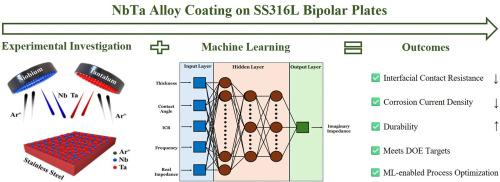Machine learning-assisted optimization of NbTa alloy coating thickness via DC magnetron sputtering for SS316L bipolar plates in PEMFCs
IF 17
1区 工程技术
Q1 ENERGY & FUELS
引用次数: 0
Abstract
Corrosion and high interfacial contact resistance (ICR) in metallic bipolar plates (BPPs) remain critical challenges limiting the durability of proton exchange membrane fuel cells (PEMFCs). This study employs a dual experimental-machine learning (ML) approach to optimize NbTa alloy coatings deposited on SS316L BPPs via DC-balanced magnetron sputtering. Electrochemical testing and surface characterization were conducted under simulated and accelerated PEMFC conditions, while an artificial neural network (ANN) model was developed to predict performance trends across coating thicknesses. A 2.5 μm coating exhibited the best overall performance, reducing corrosion current density to below 0.2 μA cm-2 and ICR to 0.9 mΩ cm2. Notably, the 1.7 μm coating also met U.S. DOE targets, representing a practical balance between cost and durability. The ANN model achieved high predictive accuracy (R2 = 0.992), validating its use in guiding experimental optimization. A preliminary techno-economic assessment indicated that NbTa alloy coatings could achieve favorable payback periods of only a few years under plausible manufacturing scenarios, reinforcing their potential for large-scale PEMFC deployment. This integrated experimental-ML framework offers a powerful strategy for accelerating the development of corrosion-resistant, conductive coatings tailored for advanced PEMFC applications.

基于机器学习的双极板SS316L直流磁控溅射NbTa合金涂层厚度优化
金属双极板(BPPs)的腐蚀和高界面接触电阻(ICR)仍然是限制质子交换膜燃料电池(pemfc)耐久性的关键挑战。本研究采用双实验-机器学习(ML)方法,通过直流平衡磁控溅射优化SS316L BPPs表面的NbTa合金涂层。在模拟和加速的PEMFC条件下进行了电化学测试和表面表征,同时开发了人工神经网络(ANN)模型来预测不同涂层厚度的性能趋势。2.5 μm涂层整体性能最佳,腐蚀电流密度降至0.2 μA cm-2以下,ICR降至0.9 mΩ cm2。值得注意的是,1.7 μm涂层也达到了美国能源部的目标,代表了成本和耐用性之间的实际平衡。人工神经网络模型的预测准确率较高(R2 = 0.992),验证了其在指导实验优化中的应用。一项初步的技术经济评估表明,在合理的制造方案下,NbTa合金涂层仅需要几年的投资回收期,这增强了其大规模部署PEMFC的潜力。这种集成的实验-机器学习框架为加速开发适用于先进PEMFC应用的耐腐蚀导电涂层提供了强有力的策略。
本文章由计算机程序翻译,如有差异,请以英文原文为准。
求助全文
约1分钟内获得全文
求助全文
来源期刊

Etransportation
Engineering-Automotive Engineering
CiteScore
19.80
自引率
12.60%
发文量
57
审稿时长
39 days
期刊介绍:
eTransportation is a scholarly journal that aims to advance knowledge in the field of electric transportation. It focuses on all modes of transportation that utilize electricity as their primary source of energy, including electric vehicles, trains, ships, and aircraft. The journal covers all stages of research, development, and testing of new technologies, systems, and devices related to electrical transportation.
The journal welcomes the use of simulation and analysis tools at the system, transport, or device level. Its primary emphasis is on the study of the electrical and electronic aspects of transportation systems. However, it also considers research on mechanical parts or subsystems of vehicles if there is a clear interaction with electrical or electronic equipment.
Please note that this journal excludes other aspects such as sociological, political, regulatory, or environmental factors from its scope.
 求助内容:
求助内容: 应助结果提醒方式:
应助结果提醒方式:


